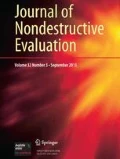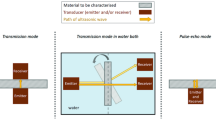Abstract
A configuration of transducers together with a self-calibrating measurement technique is proposed to investigate the reflection and transmission of surface waves by a surface-breaking or near surface defect. By means of this technique, the ratio of the reflection and transmission coefficients (R/T and/orT/R) can be obtained in a reliable and accurate manner. The reflection and transmission of surface waves for oblique incidence on a surface breaking crack is investigated in detail. Information onT/R for the latter case can be used to determine the depth of the crack. The experimental measurements ofT/R show excellent agreement with theoretical results.
Similar content being viewed by others
References
I. A. Viktorov,Rayleigh Waves and Lamb Waves — Physical Theory and Application (Plenum Press, New York, 1967).
J. D. Achenbach, A. K. Gautesen, and D. A. Mendelsohn, Ray Analysis of surface-waves interaction with an edge crack,IEEE Trans. of Son. Ultrason. SU27:124 (1980).
Y. C. Angel and J. D. Achenbach, Reflection and transmission of obliquely incident Rayleigh waves by a surface-breaking crack,J. Acoust. Soc. Am. 75:313 (1984).
B. H. Lidington and M. G. Silk, Crack depth measurements using a single surface wave probe,Brit. J. NDT 17:165 (1975).
B. Q. Vu and V. K. Kinra, Diffraction of Rayleigh waves in a half-space. I. Normal edge crack,J. Acoust. Soc. Am. 77(4):1425 (1985).
R. Dong, L. Adler, Measurements of reflection and transmission coefficients of Rayleigh waves from cracks,J Acoust. Soc. Am. 76(6):1761 (1984).
M. T. Resch, D. V. Nelson, H. H. Yuce, and G. F. Ramusat, A surface acoustic wave technique for monitoring the growth behavior of small surface fatigue cracks,J. Nondestr. Eval. 5(1):1 (1985).
B. R. Tittmann, F. Cohen-Tenoudji, M. de Billy, A. Jungman, and G. Quentin, A simple approach to estimate the size of small surface cracks with the use of acoustic surface waves,Appl. Phys. Lett. 33(1):6 (1978).
B. R. Tittmann, L. A. Ahlberg, and O. Buck, Crack closure effects in Ultrasonic NDE for real part-through fatigue cracks in Al-alloy, inReview of Progress in Quantitative NDE, Vol. 1 (Plenum Publishing Corp., New York, 1982), p. 551.
Z. L. Li, J. D. Achenbach, I. N. Komsky, and Y. C. Lee, Reflection and transmission of obliquely incident surface waves by an edge of a quarter space: Theory and experiment,J. Appl. Mech. 59:349 (1992).
F. J. Margetan, R. B. Thompson, and T. A. Gray, Interfacial spring model for ultrasonic interactions with imperfect interfaces: Theory of oblique incidence and application to diffusion bonded butt joints,J. Nondestr. Eval. 7:131 (1988).
Author information
Authors and Affiliations
Rights and permissions
About this article
Cite this article
Achenbach, J.D., Komsky, I.N., Lee, Y.C. et al. Self-calibrating ultrasonic technique for crack depth measurement. J Nondestruct Eval 11, 103–108 (1992). https://doi.org/10.1007/BF00568293
Received:
Revised:
Issue Date:
DOI: https://doi.org/10.1007/BF00568293




